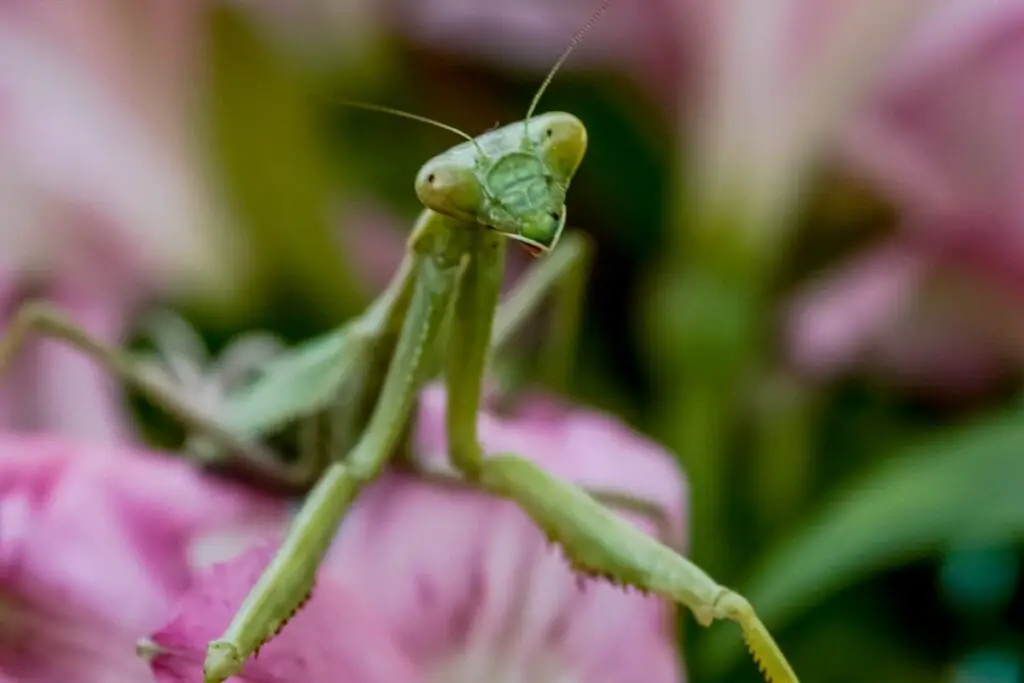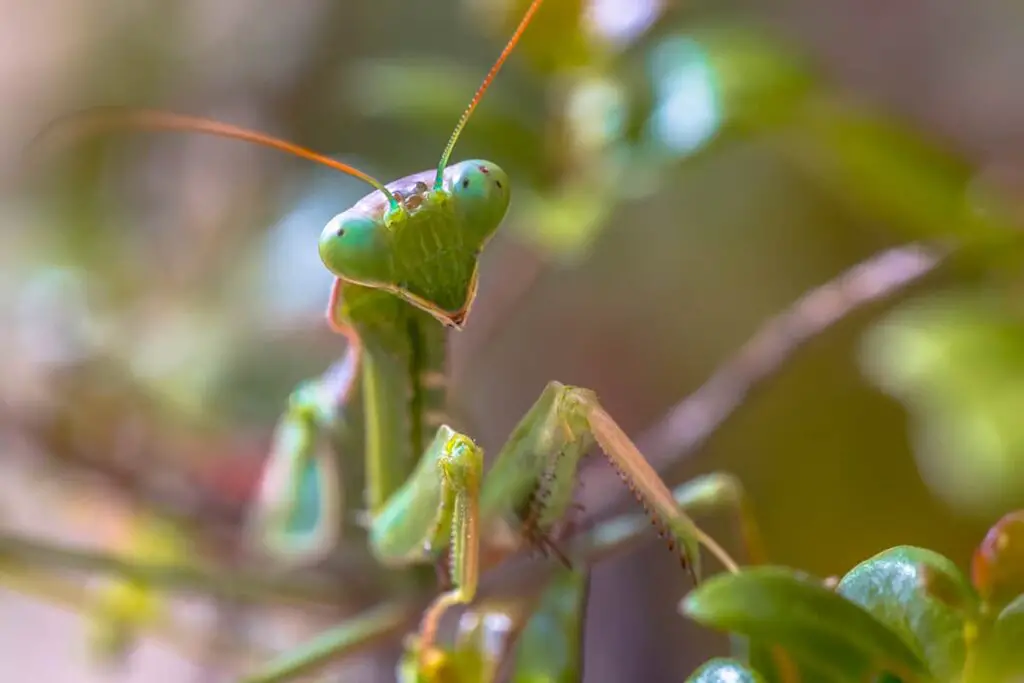Caring for a praying mantis can be a rewarding hobby, but it’s important to understand that your mantis has specific needs that vary depending on the climate it’s in. Whether you’re tending to your mantis in a humid tropical environment or a dry temperate region, adapting the care to meet the climate conditions is crucial for your pet’s health and happiness.
Different climates pose distinct challenges for mantis care. In humid climates, ensuring proper ventilation is essential to prevent stagnant air and the growth of mold, while in arid regions, your focus might shift to maintaining adequate humidity levels. Finding the balance in your mantis habitat will help your mantis thrive.
Remember, these creatures are adapted to live in a variety of environmental conditions. Learning about the natural habitat of your species of mantis can guide you in recreating similar conditions. From selecting the right type of substrate such as moisture-absorbing coconut coir for tropical species, to understanding the need for sterilized soil and the risks of pesticides, your approach to care can make all the difference.
Understanding Mantis Habitats
When you set out to care for mantises, knowing about the various climates they thrive in and the specific needs of different species is crucial. This knowledge will help you recreate the optimal environment for your mantis.
Types of Climates for Mantises
Mantises can be found in various climates around the world. Their habitats range from tropical rainforests to deserts. Here’s a brief overview:
- Tropical: High humidity and warm temperatures year-round.
- Temperate: Seasonal changes with both humid summers and cooler winters.
- Desert: Low humidity with high temperatures and drastic swings between day and night.
Each of these climates poses its own set of conditions that you’ll need to mimic for your mantis to thrive.
Common Mantis Species and Their Preferred Climates
1. Carolina Mantis (Stagmomantis carolina):
- Climate: Temperate
- Best suited for environments with distinct seasons.
2. European Mantis (Mantis religiosa):
- Climate: Temperate
- Adapts well to both warm and cooler temperatures, common in Europe and parts of North America.
3. Giant Asian Mantis (Hierodula membranacea):
- Climate: Tropical
- Requires consistently warm temperatures and high humidity.
By understanding the climatic needs of your mantis, you can ensure a healthy and comfortable habitat. Remember, each species may have unique requirements that are critical for its well-being.
Mantis Care Basics
Caring for your mantis requires attention to temperature, humidity, and proper housing to ensure a healthy and comfortable environment for your insect pet.
Temperature Requirements
Your mantis will thrive when it’s kept within a specific temperature range. Most species do well at room temperature, roughly between 65-80°F (18-27°C). Some tropical species may need slightly higher temperatures. It’s crucial to research the specific needs of your mantis species.
Humidity Needs
Maintaining the correct humidity level is vital for your mantis’s health. This typically ranges from 40% to 70%, depending on the species. Misting the enclosure with water can help achieve this, and using distilled or reverse osmosis water to prevent mineral deposits.
Housing and Environmental Setup
Provide a suitable enclosure, which should be at least three times the length of your mantis in height, and twice its length in width. Ensure there are adequate ventilation areas on opposite ends. Decorate your mantis habitat with branches and foliage to mimic their natural environment and to allow them to hang upside down for molting.
Seasonal Mantis Care
Caring for your praying mantis properly means adjusting your husbandry techniques with the changing seasons. Here’s how you can navigate their care throughout the year.
Summer Care Strategies
In the summer, your mantis will thrive in warmer temperatures, but it’s vital to avoid overheating. Keep the enclosure between 65-80°F; this is the optimal range for most species. It’s also essential to maintain airflow and prevent stagnant conditions, which can encourage mold growth. Use a misting bottle with appropriate water to lightly mist the enclosure once a day to recreate the moisture level of a summer habitat while allowing it to dry between sessions.
Winter Care Techniques
During winter, maintaining room temperature is crucial since most mantids are sensitive to cold. If the temperature drops below 65°F, consider using a gentle heat source, like a heat pad on one side of the enclosure, allowing your mantis to move towards or away from the heat as needed. To keep the humidity at an appropriate level, reduce the frequency of misting and ensure the enclosure is well-ventilated to prevent mold growth, as mantis don’t fare well in high humidity for prolonged periods.
Frequently Asked Questions
When it comes to mantis care across a range of climates, specific temperature and humidity controls are essential. Your mantis’s diet will also vary depending on its environment. Here are some tailored tips to help answer your pressing questions.
How do you ensure a suitable temperature range for mantis in various climates?
To maintain a suitable temperature range for your mantis, use heating pads or heat lamps in cooler climates. In warmer areas, ensure proper ventilation within the enclosure to prevent overheating.
What kind of environment and humidity levels are ideal for a praying mantis’s survival?
A praying mantis thrives in an environment with ample vegetation and a humidity level between 60% and 75%. Use a humidity gauge and misting to adjust levels accordingly.
What do praying mantis typically eat, and how does diet vary with climate?
Praying mantis typically consume live insects. In colder climates, you might need to provide pre-killed prey if live food is scarce. Warmer climates afford a greater variety of live insects for your mantis to hunt.
Can you provide tips for taking care of a pet mantis during the winter season?
During winter, keep your mantis warm with a gentle heat source. Avoid placing the enclosure near drafts or cold windows, and continue monitoring the humidity to prevent the air from becoming too dry.
At what temperature range do praying mantis generally thrive, and what is too cold?
Praying mantis generally thrive at temperatures between 70°F to 85°F (21°C to 29°C). Temperatures below 60°F (15°C) can be too cold and may lead to sluggishness or health issues.
What are some common strategies to maintain European mantis in fluctuating climates?
For a European mantis in fluctuating climates, create a controlled environment using thermostats for heat regulation. Providing shelters within the enclosure can also help the mantis to self-regulate its temperature.
Driven by a passion for those tiny creatures that rule our world, we at Bug Domain strive to be your go-to resource for information on insects.




